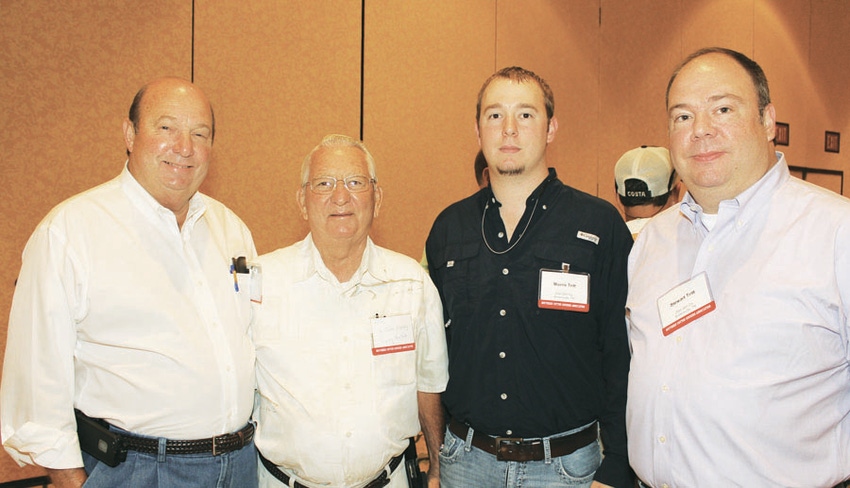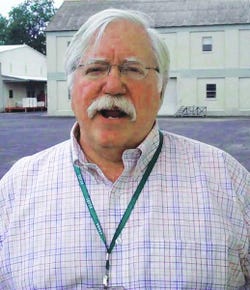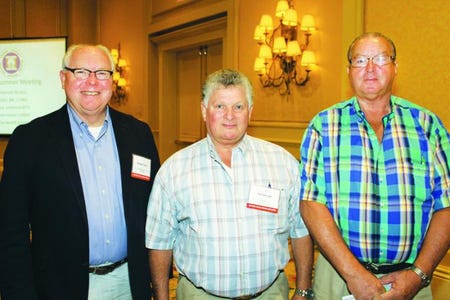
Pesky plastic: Mills don’t want it in their cotton
Plastic grocery bags, black agricultural mulch used widely in vegetable production, and other sources of plastic that make it through the ginning process and into the yarn for spinning mills have become an increasing concern, according to Tommy Valco, USDA Agricultural Research technology transfer coordinator at Stoneville, Miss.

Plastic contaminants in cotton have increased significantly in the last three or four years, says Tommy Valco, USDA Agricultural Research technology transfer coordinator at Stoneville, Miss.

TOMMY VALCO
But despite a general tendency to link the increase to the rapid and widespread adoption of the round module system, preliminary studies indicate very little of the plastic that makes it into spinning yarn, giving textile mills fits, is traced to the module covers, he says.
Rather, most of it comes from plastic grocery bags, black agricultural mulch used widely in vegetable production, and other sources.
�“Plastic in the ginning process has become an increasing concern not only for ginners, but for marketing and textile processing,” he said at the summer meeting of the Southern Cotton Ginners Association at Biloxi, Miss.
“It’s crucial that we do everything possible to keep plastic out of our cotton. U.S. cotton is some of the least contaminated in the world, and we want to do everything we can to keep it that way. We want everyone to be aware of the issue and the problems it causes in the marketing and processing of our cotton.”
Adoption of the round module harvesting system “has accelerated much faster than many expected,” Valco says. “At many gins, 60 percent to 80 percent of the cotton that’s ginned is round modules, and this has required a lot of changes to the ginning system. Even in faraway Australia, as much as 95 percent of the cotton ginned is from round modules, and these systems are going into Brazil, China, and other cotton-producing regions.
“Like any new technology, there is a learning curve, just as when the original module-builder system was introduced in the early 1970s.”
Tests at the USDA Cotton Ginning Laboratory at Stoneville have shown, Valco says, that “the thicker the plastic, the more easily it is removed by gin equipment. The wrap on round modules is relatively thick and is more easily removed by the system. Even if some of it does get into the ginned bale, 99 times out of 100 it gets removed in the textile cleaning system at the mill. We see very little yarn with module wrap plastic, but plenty with fragments of black plastic agriculture mulch, grocery bags, etc.”

RICK BYLER
Rick Byler, research leader at the Stoneville ginning lab, says while “there aren’t a lot of data on this, the module wrap is less likely to be a problem getting into yarn at mills than plastic mulch or other kinds of plastic.
“A decent size piece of module wrap could very well get through the gin and end end up in the bale that goes to the mill,” he said at the joint annual meeting of the Delta Council Ginning and Cotton Quality Committee and the Southern Cotton Ginners Association.
“Mills are finding more of this in their bales, and they’re definitely complaining about it. But these large pieces are typically removed in their cleaning process and aren’t likely to get into the yarn. I’ve not seen any module wrap plastic I’m convinced made it into the final yarn.”
Round modules use a multi-part wrap, Byler notes. “One part of the wrap isn’t stuck to anything, and if you cut into it, that piece will be completely loose and will tend to go into the seed cotton pile. From there it can get into the module feeder, wrap around the beaters, and get beaten into little pieces, some of which can make it into the final bale.”
While there are automated systems to properly cut and remove the wrap from round modules, he says because of the cost and problems with misalignment, most gins are not using them, but rather are cutting the wrap manually.
Cut module wraps properly
“It’s important that these modules be cut properly so nothing goes into the seed cotton,” Byler says. “Training is important — the person making the cut needs to know where to cut so all the plastic wrap can be removed.”

SLEDGE TAYLOR, from left, Como Consolidated Gin, Como, Miss.; Pat George, TJ Beall Co., Cleveland, Miss.; and Phil Lucius, Calhoun County Gin, Calhoun City, Miss., were among those attending the summer meeting of the Southern Cotton Ginners Association.
As for the problem with plastic grocery bags, ag mulch, and other thin plastic contaminants, he says, “Probably the most effective thing that can be done is for ginners to work with their farmers and impress on them the need to keep plastic out of their modules. A lot of farmers use custom harvesters, and they need to be brought into the loop also. Once plastic mulch or plastic bags or other contaminant material gets into the module, it has an impact all along the line.”
The round module system is still relatively new, Valco says. “People are still learning how to deal with it, and increased awareness of the contamination problem at the grower level and at the gin will help to resolve it.”
Byler and researchers at the ginning lab did a preliminary study to see what would happen when various kinds of plastic were introduced into the gin on purpose, and where those pieces would end up. Plastic types included not only round module covers, but irrigation tubing, grocery bags/shopping bags, and plastic mulch.
“Plastic was cut into square and rectangular sizes, all the way up to 3x6 inches, which were then introduced into the seed cotton going through the micro-gin,” Byler says.
“After it ran through the gin, we spent hours determining where all the plastic went, a very labor-intensive process. But it gave us a pretty good idea of where most of the plastic was being removed, where other plastic got through, and how we can improve or change the system to do an even better job.
“The biggest problem we saw was black plastic mulch. The larger pieces that got shredded went through the gin stand and lint cleaner and ended up in the lint. Some of the smaller pieces were taken out by seed cotton cleaning devices. Plastic from round module covers was found the least in the lint.
“What we found was that the smaller pieces, 1x1-inch, acted like leaf and were taken out by the cylinder cleaners, while the larger, heavier materials were removed either by stick machines or extractor feeders. About 56 percent of the plastic that we put into the seed cotton was taken out by the stick machines.”
Unfortunately, Byler says, “A lot of gins have started bypassing stick machines, particularly if they’re running good clean cotton. Stick machines are where there are potential losses of seed cotton. So, this is potentially something we need to rethink in terms of plastic contamination.”
Smaller amounts are being taken out by cylinder cleaners and lint cleaners, he says, and about 12 percent of it “we never found.”
Of the plastic introduced into the ginning system, about 17 percent was later found in the lint.
The study led to an effort, in cooperation with Cotton Incorporated and the National Cotton Ginners Association, to establish an education program on handling of round modules from the field to the gin.
“John Deere was very helpful in assisting us with the project,” Valco says, including a “Focus on Cotton” webcast on steps for reducing the potential for plastic contamination. “This is intended more for producers and custom harvesters than ginners. John Deere understands the contamination issue, and they want to be part of the solution.”
Keys to handling modules
Among the suggestions for proper handling of round modules:
PROPER SPACING and handling of round modules can help eliminate plastic in the ginning system.
·Staging modules in the field so they are properly aligned, with proper spacing between modules. “If they’re too close together, rain can cause mold/mildew growth and degradation of the cotton,” Valco says. “We recommend spacing them 4 inches to 8 inches apart to allow for air circulation and drying.
“This also helps with loading them on the module truck to keep wrap from splitting. Round modules work great as long as the wrapper is in place and integrity is sound. If they come into the gin with rips or the wrapper falling apart, it creates a new level of problems.”
·Modifying module trucks for handling the round modules is important, Valco says. “Ginners need to be sure lugs on the trucks have been modified to be less aggressive, and that feed chains are modified so they don’t cause ripping and tearing, which can introduce plastic shards into the system. Chain speed and ground need to be fully synchronized. It’s also essential to keep operators trained on proper handling techniques.”
·Round modules can be transported on flat-bed or drop-bed trucks, he says. “This system has changed the whole paradigm for transporting modules to the gin. I’ve seen 10 or more of these modules on a flat-bed truck. This is legal on Interstate highways, but it often results in modules being transported much farther, often bypassing several gins on the way to a more distant facility.
·The wrap used for round modules “is a complex, multi-layer system, which is not cheap,” Valco says. “It’s a unique container that provides both protection and support.
“We’ve identified proper cut zones for the wrappers, and with the help of the National Cotton Ginners Association, Cotton Incorporated, and John Deere, posters have been created, showing preferred cut areas. These have been sent to all gins.
“If a wrapper is cut at a wrong spot, there is a good chance you’re going to get a tail that can end up getting into the gin and creating problems. Make sure your employees are aware of the proper places to cut these wraps.”
There are several automated systems for removing the wraps, he says, “but some gins have stopped using them because of the added time required and potential misalignment, and are doing the cuts manually.” There are also semi-automated systems, which some gins are using.
In addition to plastic contaminants, the 2012 cotton crop in the Mid-South and Southeast had “extremely high levels” of bark, Valco says. “Bark was particularly high in the Southeast, and relatively high at the Memphis and Dumas, Ark., classing offices — much higher than in 2011.
“What’s causing this? We don’t really know. We’ve discussed it quite a bit, and every ginner has an idea. Many blame it on new varieties, others on the round module system, disease, weather, classing office procedure changes, etc.
“Some gins are making modifications to their system to do a better job of removing bark. We do know that stick machines do the best job of removing bark — they’re the best defense we have. If you’re letting sticks get into your gin stand, the potential for bark is increased. Two stages of lint cleaning help as well, but a lot of gins have gone to just one stage. We’re going to keep a close eye on this.”
Ag news delivered daily to your inbox: Subscribe to Delta Farm Press Daily.
Rick Byler said at the Delta Council/SCGA meeting that some think the increased barkiness is related to disease, “which is killing cotton before it matures; the bark gets loose and mixes with cotton when it’s harvested.
“Some say gins are bypassing extractors. Our data show that extractor-type cleaners are best for removing bark. If you’re having bark problems, you need to be using these.”
In years past, Byler says, many gins used two lint cleaners. “Now, hardly any of them use two lint cleaners. But that second lint cleaner will reduce barkiness.”
About the Author(s)
You May Also Like



